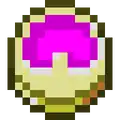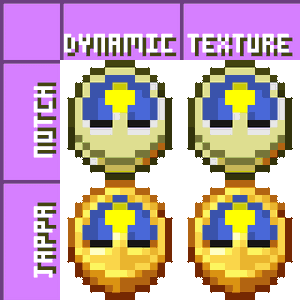Procedural animated texture generation/Clocks
To generate its appearances, the clock combined 2 textures, one being the actual clock, and the other being the dial.
-
 Clock texture file
Clock texture file -

dial.png
The logic solely for mixing the two (as there is additional logic for moving the dial in a wobbly fashion that isn't pertinent here) is as follows:

# Assume RGBA values are handled as 0.0 to 1.0 float values
def setup_clock_sprite (item: Image, dial: Image, dial_angle: float, output: Image):
rx = sin(-dial_angle)
ry = cos(-dial_angle)
for y in range(item.height):
for x in range(item.width):
pix = item.get_pixel(x, y)
if pix.r == pix.b and pix.g == 0 and pix.b > 0:
u: float = -(x / (item.width - 1) - 0.5)
v: float = y / (item.height - 1) - 0.5
dial_pix = dial.get_pixel(
int(((u * ry + v * rx + 0.5) * dial.width)) % dial.width,
int(((v * ry - u * rx + 0.5) * dial.height)) % dial.height
)
dial_pix.rgb *= pix.r
pix = dial_pix
output.set_pixel(x, y, pix)
This results in the item and dial sprites being mixed by fuchsia areas of the clock sprite, as well as being shaded by them (contrary to the popular belief that they were mixed solely on the two shades found on the vanilla sprite). This allowed for the clock to be animated precisely, having 230 visually distinct frames, in an era where block and item sprites couldn't be animated individually without mods. The pre-rendered animated approach, used in 1.5 onward, is far less precise, with only 64 different frames.

Due to an oversight with how assets were loaded however, the item sprite for clocks couldn't be overridden by texture packs (as they are set to always load from the vanilla gui/items.png atlas, stored in minecraft.jar, rather than the one of the currently active texture pack.